In this material we will describe how to get rid of black flies in room flowers with folk and special means, namely from the following 3 types:
- Drosophilus, which are also called fruit or fruit flies. They look more like small flies.
- Sciarid, other names are flower midges or mushroom mosquitoes, and they are really very similar to small black mosquitoes.
- Whitefly or Aleroydid that look like small white or light gray small aphids. They settle mainly under the leaves.
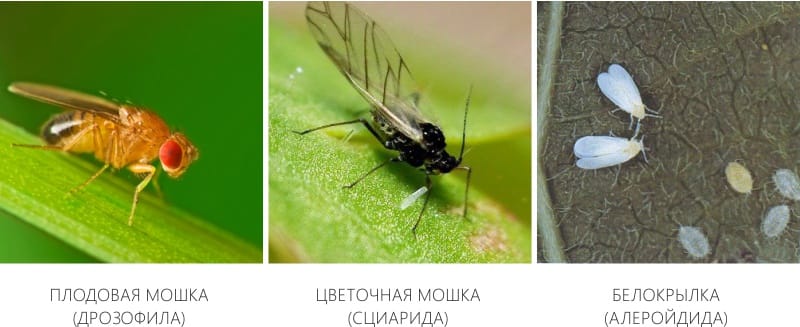
Species of blackflies
We will look at ways to combat fruit and flower flies in the first chapter, but if white flies have settled in your plants, then you can learn how to get rid of them in the second part of the material.
How to get rid of fruit and flower midges (fruit fly and sciaride)
Blackflies in flowers are not only flying small flies, but also their larvae that live in the ground. In one pot, several generations of insects can develop simultaneously, from eggs to adults. Also, keep in mind that mushroom mosquitoes can quickly spread from one plant to another. Therefore, to remove insects forever, you need to deal with them in a complex and often repeatedly.
Because of what appear black flies in indoor colors: A common cause is that they could appear when a plant was transplanted into purchased land that was already infected with eggs and larvae. In addition, the midges could just fly into the summer or autumn period from the window and settle in your colors. Anyway, the main factor in the occurrence and reproduction of stsiarid and fruit flies is wet, transfused soil, which attracts midges and creates favorable conditions for the transformation of dormant eggs into larvae. By the way, Drosophila could get into your apartment along with purchased vegetables, fruits, or fly to the smell of a stale product, and then choose your flower pots.
Damage caused: the adults themselves are harmless, but their larvae, feeding on the sap of the roots, destroy the plant. Particularly dangerous flower midges for seedlings and young plants.
Prevention: watering the plants as they dry 2 cm of the top layer of the earth, as well as periodically loosening and timely removal of diseased leaves. Moderate watering will make the soil less attractive for oviparous adult midges and less fertile for the development of larvae.
Methods of struggle
Instructions 1. With the help of folk remedies
Step 1. Let the ground dry after the last watering so that at least 2 cm of the top layer is dry.
Step 2. Catch all adults. This can be done using:
- Traps: special (eg, the usual tape for catching flies) or self-made ones. To make your own black fly trap, you need yellow cardboard (or cardboard painted with yellow paint), as well as honey. Yellow cards need to coat with a thin layer of honey and hang (arrange) near the pots. Remember to change traps as needed.
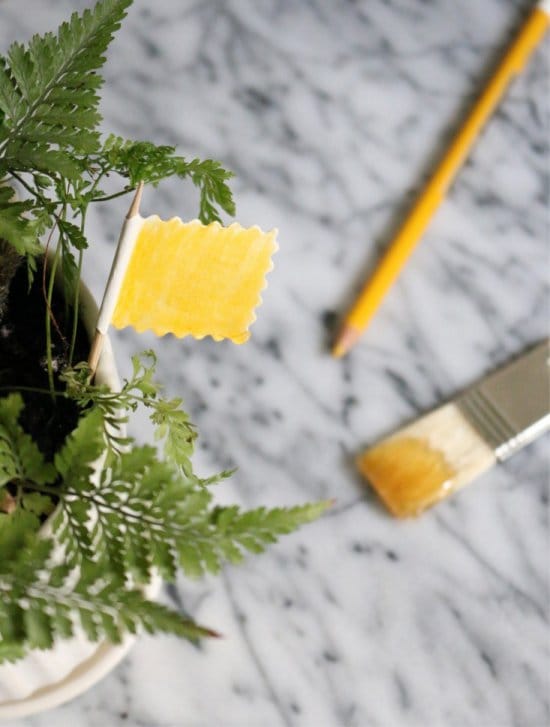
Homemade flower fly trap
- Vacuum Cleaner: remove the nozzle or put a small nozzle without a brush on the hose and simply treat the ground and the window sill. The vacuum cleaner will easily tighten insects even in flight. After that, the bag must be discarded (if it is disposable) or emptied outside the apartment, and then treated with dichlorvos.
Step 3. So, we got rid of adult oviparous midges, now we need to cultivate the ground to get rid of the larvae. To do this, loosen the dried soil and water the plant with one of the following folk remedies:
- Garlic infusion: make a garlic extract at the rate of: 1 rubbed head of garlic + 600 ml of boiling water per 1 flower pot. Let the medium stand for 2-4 hours, then pour and spray the plant with it, and deepen the remaining pulp into the ground. You can also stick one head cut into three parts into the soil of each infected plant. Do not worry, the smell of garlic in the apartment will not appear.
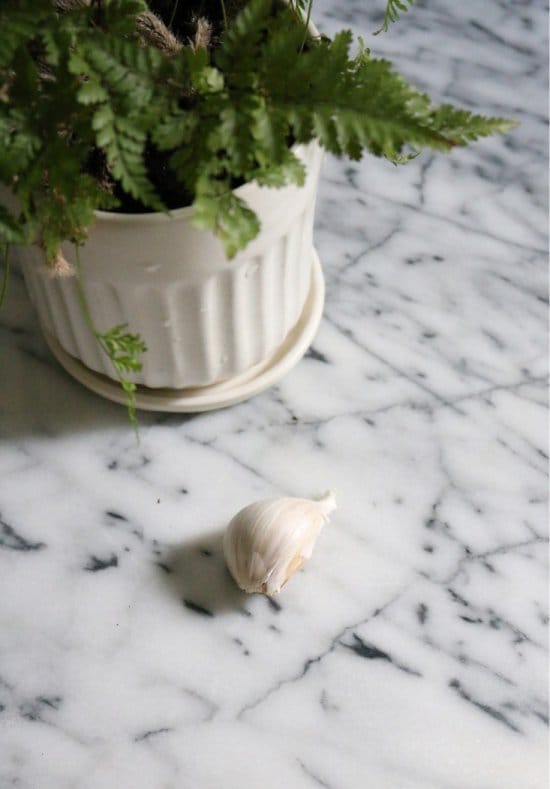
Garlic as a natural insecticide for flower midges
- Manganese solution: it must be so weak that it appears colorless in the palm of your hand. Water and spray the plant with a solution no more than 1 time per week during the month.
- Soap solution: Grate 20 g of household soap and dissolve it in a liter of warm water, then pour and spray the plant with the resulting solution.
- Sulfur: stick 4 matches in the ground with the heads down at the same interval and water the plant a little. During the week, change the matches every other day.
- Antiparasitic solution for pets: buy anthelminthic drugs at the pet store, for example, Drontal. Means in a dosage that is suitable for cats or puppies, dilute in water and water the plant as usual. After a week, the procedure is desirable to repeat.
Instruction 2. Using insecticides and creating a "toxic greenhouse"
This method is effective, economical and, if done correctly, is safe for humans and plants. With it, you can kill the larvae and adults.
Step 1. Wait until the soil is dry after the last watering.
Step 2. Loosen the ground gently.
Step 3. Put the plant pot in an ordinary bag, spray a little “Dichlorvos” into the soil and tie the bag tightly so that only the pot is completely closed. After 4-5 hours, the midges in the ground should die.
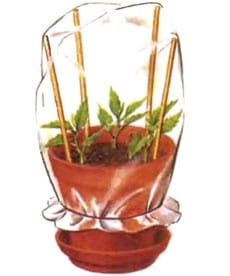
- If the midges bred not only in the ground, but also settled under or above the leaves, then you need to do all the same steps, but pick up a package of such size that it fits the whole plant "in full growth", and spray Dichlorvos not only in soil, but also on the package (!). In order not to damage the plant, it is important that the product does not fall on the leaves, and that they do not stick, you should fix the package with scotch tape at the right height to the furniture, door or floor lamp. Another way to create a "greenhouse" is shown in the picture on the right. The tool will destroy insects in the ground and on the leaves in 7-10 hours.
- Dichlorvos can replace Raptor, Neo or Raid. In addition, instead of sprays, you can use solutions from special insecticides for plants, for example, Thunder-2, Aktar, Basudin, Aktellik and Karbofos. In this case, before wrapping the plant in polyethylene, it needs to be watered and sprayed with the product.
Step 4. Hang up on the window sill special or homemade traps, so that the remaining midges that did not fall under the package sat on them.
Step 5. Repeat the procedure after 8 days to eliminate the possibility of the recurrence of blackflies.
If there are a lot of larvae in the soil, and you are sure that the plant will survive the transplant, then it is best to do this by transplanting the flower into a new, previously treated soil. To do this: loosen the ground and gently pull it out, then manually or with a small brush clean the roots of contaminated soil, then quickly rinse the roots with water or one of the above household tools and finally, transplant the plant into a clean pot with uninfected soil.To prepare the earth, it must be calcined in the oven at a temperature of 100-120 degrees for 1 hour, and then the microflora must be restored with any fertilizer.
How to get rid of the whitefly
To get rid of the whitefly, you also need to carry out comprehensive measures for the destruction of adult insects and larvae 3-4 times with an interval of one week.
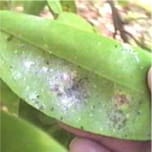
Whitefly Leaf
Damage caused: Whiteflies themselves do not harm the plant, but because of their excrements, black fungi can appear on the lower leaves, which can severely damage the flower. In addition, white midges can infect a plant with a viral infection. On the right is a photo of a leaf affected by white-winged.
Methods of struggle
Step 1. First you need to catch all adult flies. This can be done in the following ways:
- Arrange the special or homemade traps described in the first instruction.
- Catch all midges with a vacuum cleaner.
- Pour the jam in the saucer, put it next to the pot and wait until the whiteflies fly off the bait and get stuck in it.
- In the morning, create a light coolness in the room where the flowers are located, for example, by turning off the batteries or opening a window. Low temperature will prevent the flies from taking off. Next, perform the procedure described below.
Step 2. Once the majority of the adults have been caught, take the plant to the bathroom and rinse the leaves from the remaining insects, eggs and nymphs.
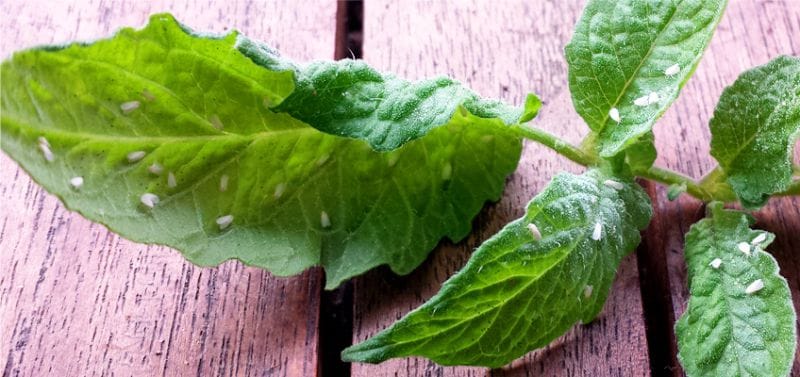
Step 3. Now treat the plant with irrigation and spraying with solutions from systemic insecticides (Actellic, Confidor, Mospilan or Fufanon), and then create a toxic greenhouse by closing the plant in a plastic bag for 4-5 hours.
- If whitefly is not so much, then instead of special means you can use the garlic brew, described in the first instruction.
Step 4. If desired, transplant the plant into uninfected land and discard contaminated soil.
There is another way to destroy whitefly in indoor colors. If an infected plant can tolerate temperatures below 14 degrees, then just leave it in such coolness for a week or a bit more. Unable to withstand low temperatures, the whitefly and its larvae will die.
- How to get rid of bugs in the kitchen?
- How to get rid of moths in the kitchen forever in 5 steps
- Blackflies in the kitchen! Who are they and how to get rid of them
- Indoor flowers and plants for the kitchen - choose unpretentious, useful and beautiful
- How to clean the pan outside and inside - 8 simple ways for difficult cases
- How to descale the kettle - 5 home remedies
For details on how to get rid of black flies in indoor plants, see the next video tutorial.



 (Rate the material! Already voted:72 average rating: 4,54 from 5)
(Rate the material! Already voted:72 average rating: 4,54 from 5)
I poured sunflower oil in a bowl and put it near the pot, so in a few days it made 100 black flies in a pot :-)))